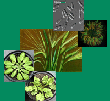| Kerl, C; Schindele, RA; Brüggenwirth, L; Cloina Blanco, AE; Rafferty, C; Clemens, S; Planer-Friedrich, B: Methylated thioarsenates and monothioarsenate differ in uptake, transformation, and contribution to total arsenic translocation in rice plants, Environmental Science & Technology, 53, 5787-5796 (2019), doi:10.1021/acs.est.9b00592 [Link] | |
| Abstract: Methylated and inorganic thioarsenates have recently been reported from paddy fields besides the better-known oxyarsenates. Methylated thioarsenates are highly toxic for humans, yet their uptake, transformation, and translocation in rice plants is unknown. Here, hydroponic experiments with 20 day old rice plants showed that monomethylmonothioarsenate (MMMTA), dimethylmonothioarsenate (DMMTA), and monothioarsenate (MTA) were taken up by rice roots and could be detected in the xylem. Total arsenic (As) translocation from roots to shoots was higher for plants exposed to DMMTA, MTA, and dimethylarsenate (DMAV) compared to MMMTA and monomethylarsenate (MMAV). All thioarsenates were partially transformed in the presence of rice roots, but processes and extents differed. MMMTA was subject to abiotic oxidation and largely dethiolated to MMAV already outside the plant, probably due to root oxygen loss. DMMTA and MTA were not oxidized abiotically. Crude protein extracts showed rapid enzymatic reduction for MTA but not for DMMTA. Our study implies that DMMTA has the highest potential to contribute to total As accumulation in grains either as DMAV or partially as DMMTA. DMMTA has once been detected in rice grains using enzymatic extraction. By routine acid extraction, DMMTA is determined as DMAV and thus escapes regulation despite its toxicity. |

